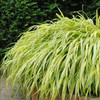Product Description
Hakonechloa macra 'Aureola'(30)ct Flat
Common Name: Hakone Grass, Japanese Forest Grass, Ornamental Grass
An intriguing grass for the shade which is perfect for the formal Japanese garden. Variegated but nearly all yellow, the leaf blades have narrow green stripes, mostly near the margins. Perhaps its most fascinating attribute is the cascading habit in which most of the leaves arch in the same direction, appearing much like a golden waterfall. Plant this grass where it will cascade down slopes, drape over rocks, crawl over the edges of walls, at the front of the garden, or even in containers.
Though this grass does spread by rhizomes, it is a slow grower and will not rapidly overtake its neighbors. When grown in part shade, the yellow tones in the leaves will be most pronounced. In deep shade, the variegation will be lime green. In the cooler days of autumn, the golden foliage becomes infused with shades of pink and red. People in milder climates will be able to enjoy the buff color of this grass all winter. In colder climates, it will die all the way back to the ground.
Hakonechloa is grown mainly for its beautiful foliage, though it does produce seed heads. Tiny, inconspicuous flower spiklets appear in airy clusters from late summer thru early fall.
Hakonechloa is most at home in shaded, woodland environments where the soil is rich and loamy. This grass will not grow in poorly drained soil, heavy clay, or very dry soils. Part to full shade is best; full hot sun tends to scorch the leaves.
Since it is such a slow grower, it will not be necessary to divide this grass for many years. However, division is easily accomplished and may be done in spring or fall. In zones 5-6, mulch it with fall leaves to a depth of about 2 feet and cover the pile with branches to keep the mulch in place. In southern zones, this mulch is not necessary. In early spring, remove the leaves and cut back last year's foliage to allow room for the new growth.
Perennial Plant Association Plant of the Year -- 2009
Royal Horticultural Society's Award of Garden Merit -- 1993
Height: 1.0-2.0 Feet
Spread: 2.0-3.0 Feet
Hardiness Zones: 5,6,7,8,9
Flower Color: Tan shades
Foliage Color: Variegated
Part Shade (4-6 hrs. Direct Sun) - Full Shade (< 4 hrs. Direct Sun)
Average to Consistent Water Needs
Average to Fertile Soil Quality
Bloomtime: Late Summer -Early Fall
Deer Resistant
Seasonal Interest: Fall Color
Growth Rate: Slow
Border Plant, Container, Edging, Attractive Foliage, Mass Planting, Specimen, Focal Point
Thirty (30) plants per flat (or tray). Approximate Plug Measurements: 4.25 inches deep x 2 inches wide.
Other Details
The most important part of the plant is its root system. Healthy roots are the foundation of a healthy, vibrant plant. The type of plug container used is based on the specific needs of the plants. Perennials offered as bare root traditionally perform better when planted as bare root.Planted in a specialized mix, potted plants have well established root systems. Top growth stage will vary depending on the current life cycle and time of year when shipped. In Winter and early Spring dormant plants may be shipped. Dormant plants may be planted right away, even before the last frost date.
Most bare root varieties are field grown for at least one season, though Hemerocallis and Hosta are grown for two seasons. The bulk of the soil is removed during the harvesting process and the tops of most varieties are trimmed back to the crown. They are graded, packed in shredded aspen or sphagnum moss and stored in freezers until ready to be shipped.
See our Container Sizes and Bare Root Perennials pages for more information.
Plant information and care is provided in the Overview section, Plant Genus Page and general information is provided in the Planting Care & Guides. Additional questions can be asked on each Plant page.
Plant Spacing: Using the maximum mature spread or width of a plant to guide spacing, ensures space to grow to full size. To fill an area sooner, plant them closer together. Just remember, future thinning or transplanting may be needed.
Water: Keep a close eye on newly planted perennials, especially throughout the first growing year. Most early plant loss is due to too much or too little water!





















